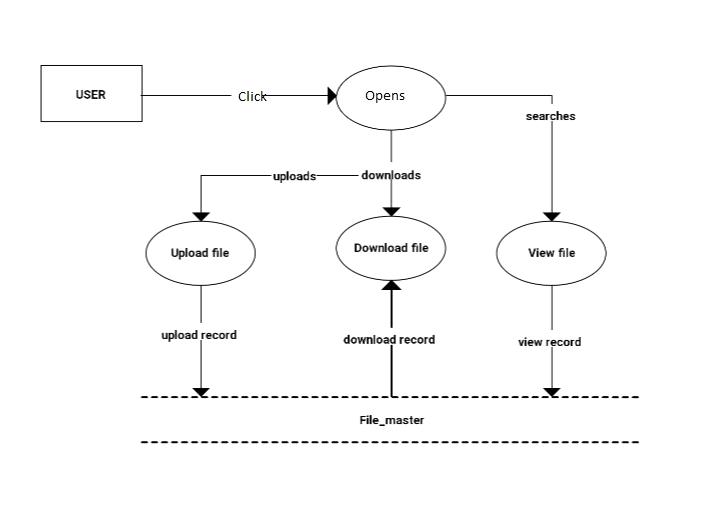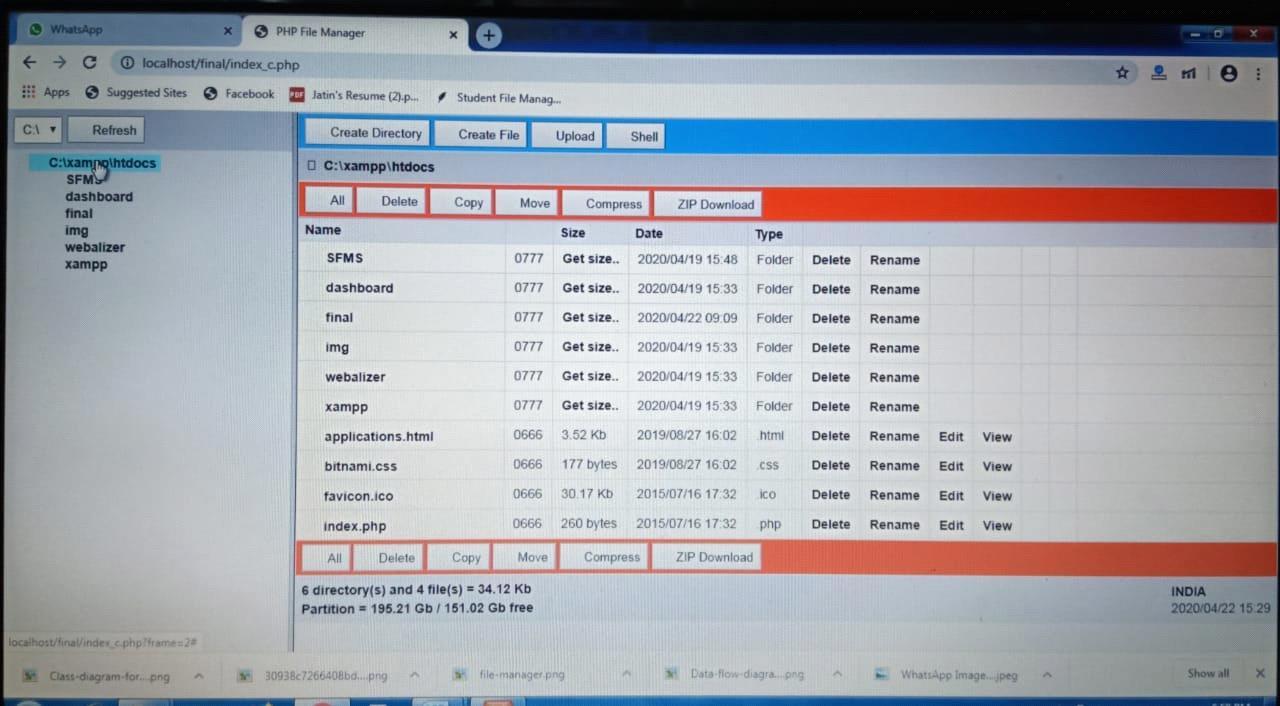ISSN 2348-1196 (print)
International Journal of Computer Science and Information Technology Research ISSN 2348-120X (online) Vol. 8, Issue 2, pp: (74-78), Month: April - June 2020, Available at: www.researchpublish.com

ISSN 2348-1196 (print)
International Journal of Computer Science and Information Technology Research ISSN 2348-120X (online) Vol. 8, Issue 2, pp: (74-78), Month: April - June 2020, Available at: www.researchpublish.com
1Nikhil Kumar, 2Akshay Bansal, 3Kartik Singhal, 4Pratham Sharma, 5Dr. Vinesh Kumar
Department Of Computer Science and Engineering MIET, Meerut {nikhil.kumar.cs.2016,akshay.bansal.cs.2016,kartik.singhal.cs.2016,pratham.sharma.cs.2016, vinesh.kumar}@miet.ac.in
Abstract: The project entitled File MANAGEMENT SYSTEM is a System software developed in PHP to create software for managing files by providing a changes in the systems files. The software solution provides facility for manipulating the internal operation of the firm. . File Management System is an efficient, time saving and easy way to report, view and control the version of a file. It is now an easy task and managing it is much easier. FMS, a suite of programs that automates away most of the drudgery involved in keeping an annotated history of your project and avoiding modification conflicts. Most FMS share the same basic logic. To use one, start by registering a collection of source files that is, telling your FMS to start archive files describing their change histories. Thereafter, when you want to edit one of these files, you have to check out the file assert an exclusive lock on it. When you're done, you check in the file, adding your changes to the archive, releasing the lock, and entering a change comment explaining what you did..
Keywords: File-Management-System, systems files, source files, software developed.
A file manager or file browser is a computer program that provides a user interface to work with file systems. The most common operations used are create, open, edit, view, print, play, rename, move, copy, delete, attributes, properties, search/find, and permissions. Files are typically displayed in a hierarchy. Some file managers contain features inspired by web browsers, including forward and back navigational buttons. Some file managers provide network connectivity. In Windows the program that does this is called Windows Explorer.
Thought file management was just for paper files? Think again. It’s just as important to keep the files on your computer organized and up-to-date. Just as with paper files, the goal of computer file management is to ensure that you can find what you’re looking for, even if you’re looking for it years after its creation. These file management tips will help you keep your files accessible:
1. Organise by file types.
2. One place for all.
3. Create folders in My Documents.
4. Be specific.
5. Order your files for your convenience.
6. Back up your files regularly.
7. Cull your files regularly.
8. Follow the file naming conventions. 9. Nest folders within folders.
10. File as you go.
ISSN 2348-1196 (print)
International Journal of Computer Science and Information Technology Research ISSN 2348-120X (online) Vol. 8, Issue 2, pp: (74-78), Month: April - June 2020, Available at: www.researchpublish.com
A file management system is a type of software that manages data files in a computer system. It has limited capabilities and is designed to manage individual or group files, such as special office documents and records. It may display report details like owner, creation date, state of completion and similar features useful in an office environment.
The data that we work with on computers is kept in a hierarchical file system in which directories have files and subdirectories beneath them. Although we use the computer operating system to keep our image data organized, how we name files and folders, how we arrange these nested folders, and how we handle the files in these folders are the fundamental aspects of file management. The operating system’s organization of our data can be enhanced by the use of cataloging programs, which make organizing and finding image files easier than simply relying on the computer’s directory structure.
File Management is very important, because if they are not stored in an ordered, methodical way you may never be able to find them again. Secondly, files need to be backed up. USB’s, CD’s and even hard drives can become corrupted.

Following diagram is drawn with three main activities-
1. Select File 2. Select Operation 3. Perform
After receiving request from user for a particular file, user is again requested to select a operation and then condition checks are performed to check whether it is granted or not. If permission is granted then user is allowed to perform operation and also proceed to further more operation. If not granted then user is requested again to select a opeation until permission is not granted.
ISSN 2348-1196 (print)
International Journal of Computer Science and Information Technology Research ISSN 2348-120X (online) Vol. 8, Issue 2, pp: (74-78), Month: April - June 2020, Available at: www.researchpublish.com

When working with applications and files, you will often use the Copy, Cut, Move, Delete and Paste actions. It is important to understand the differences between them and how they work.
Delete: In the case of items inside a file, Delete deletes an item from the screen without storing it in memory. In the case of files or folders, Delete deletes items from the screen but moves them to the Recycle Bin.
Cut: In the case of items inside a file, Cut deletes the content from the screen, but keeps it in memory .
Move: Moves an item from one location to another.
Paste: Used to make a cut or copied item appear again at a specific location.
Copy: Makes a duplicate of the original file, which can be moved or edited without altering the original.
Zip: It is a common type of file compression . "Zipping" one or more files creates a compressed.
Upload: To transfer (something, such as data or files) from a computer or other digital device to the memory of another device .
Remove: To remove from a document or record: deleted the names from the computer file. See Synonyms at erase.
ISSN 2348-1196 (print)
International Journal of Computer Science and Information Technology Research ISSN 2348-120X (online) Vol. 8, Issue 2, pp: (74-78), Month: April - June 2020, Available at: www.researchpublish.com
iv. Zip v. Rename vi. Delete 4. Perform operation. 5. For other or same type operation goto step 2. 6. Stop.
•
File Management System has capability to store different kinds of files, some of them are JPEG, PNG, GIF, PDF, MP4.

JPEG: JPEG is the foremost common arrange utilized by advanced cameras and pictures living on the World Wide Web. This record arrange is based on lossy compression, meaning that it keeps data that's obvious to the watcher and gets freed of information that the human eye can’t see.
PNG: PNG may be a high-quality record organize utilized for pictures. This record type is based on the lossless compression, which implies that it bolsters high-quality pictures for online utilize whereas holding the initial picture colors and sharpness. Not at all like JPEG records, PNGs moreover back pictures with straightforward foundations.
GIF: The GIF record could be a shape of bitmap pictures, meaning the realistic is composed of numerous minor parts called pixels, similar to the JPEG and PNG record groups. This record sort is based on LZW (Lempel-Ziv-Welch), a extraordinary frame of the lossless information compression calculation.
PDF: This file format is used for online documents and printing purposes. PDF records can contain numerous distinctive components: content, photographs, vector pictures, recordings, sound records and indeed intelligently components like shapes and buttons.
MP4: MP4 may be a mixed media holder organize, which is fair a favor term for most of the recordings we expend on the Web. This record can contain video, sound, and subtitles. In summary, this is the best choice for creating or saving video files to your website, social media and more.
ISSN 2348-1196 (print)
International Journal of Computer Science and Information Technology Research ISSN 2348-120X (online) Vol. 8, Issue 2, pp: (74-78), Month: April - June 2020, Available at: www.researchpublish.com
Fig. 4
Record Management System utilizes PHP File Manager to make reference to the yield. On bases of the considerable number of registries in your framework, it made a decision about them and spot them in single spot with data like record stockpiling date and time data.

At that point client can without much of a stretch view every single catalog with basic and brief route. Client can likewise perform diverse sort of activity like VIEW, COPY, MOVE, COMPRESS, ZIP, RENAME, DELETE on the documents.
With these valuable data client can physically follow status of the considerable number of catalogs in your framework and let to realize what records are important and which are not, and afterward effectively oversee memory of your framework.
The project entitled File MANAGEMENT SYSTEM is done in an effective manner. File Management System is an efficient, time saving and easy way to report, view and control the version of a file. All the operations are done efficiently. To use one, start by registering a collection of source files that is, telling your FMS to start archive files describing their change histories. Thereafter, when you want to edit one of these files, you have to check out the file assert an exclusive lock on it. When you're done, you check in the file, adding your changes to the archive, releasing the lock, and entering a change comment explaining what you did.
Morison(O’Reilly).